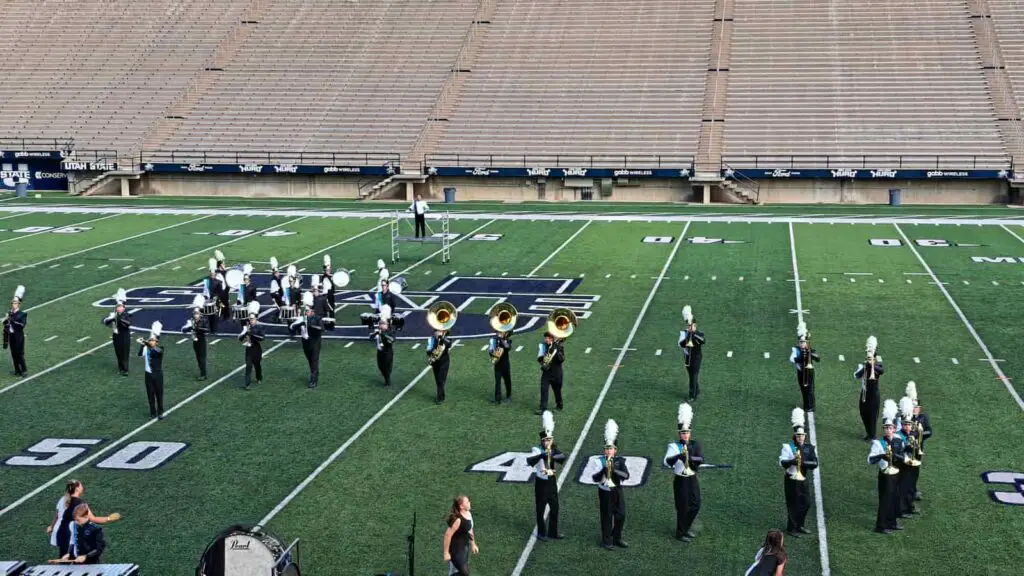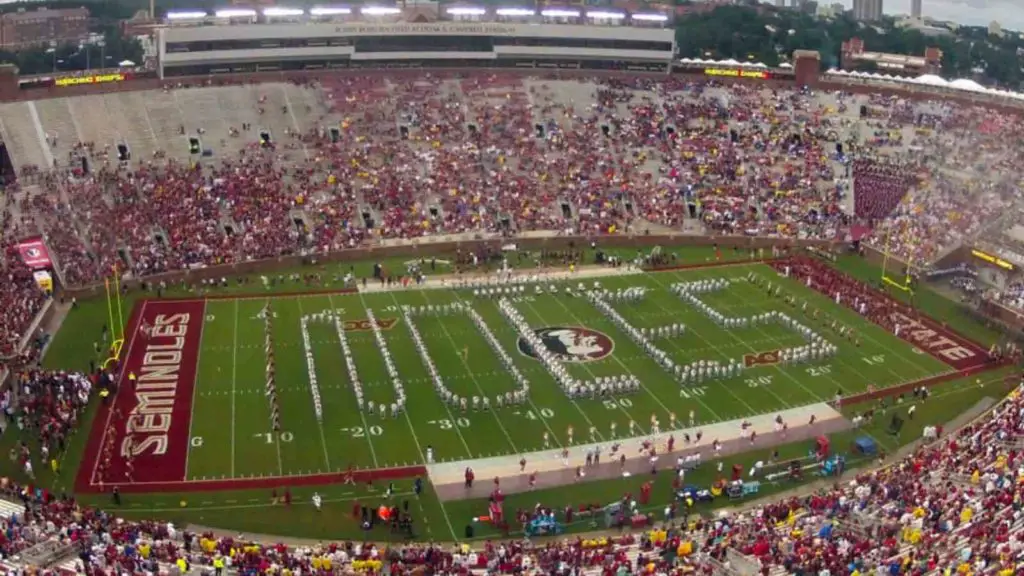If you’ve watched a marching band field show, you’ve seen individual marching band members move around to different places on the field. The band members create pictures, show movement, or a combination of both. How do the band members all know where to go? How do they not bump into each other?
Marching band members follow a drill chart which gives them coordinates to follow throughout the field show. Coordinates on a drill chart are broken down into sets or pages; each set is a certain number of counts. Marching band members can move for a certain number of counts, or hold in place.

We will help answer your questions about marching band formations, and explain how marching band members learn the show.
How many sets or pages are in a marching band show?
Drill charts can be any number of sets or pages. Generally speaking, the more sets you have in the drill chart, the more complex and difficult the show is.
Sometimes, marching bands have shorter movements of music within a field show and might hold in the same set for a longer time. If you see lots of movement and frequently changing formations, this means marching band members had to memorize more sets.
The movement you see is usually when marching band members are moving from one set to another set. Sometimes, marching band members can add movement while staying in the same set, but the movement is not as noticeable.
How long is each marching band set?
Oftentimes, one set aligns with a musical phrase. Musical phrases are like musical sentences and are frequently 8 or 16 counts. Keeping sets around this number and aligning them with the music makes them easier to remember and represents the music visually.
Sets can also be 32, 48, or more counts. Longer sets are not as common and if used, they are usually when band members are holding in one place while playing. Shorter sets can happen as well, and sometimes there are many different shorter sets in a row to create more motion in the drill designs.
If band members are moving during these longer count moves, they are sometimes broken down into smaller subsets. Odd number phrases definitely happen as well but are also not as common.

Are longer sets more difficult?
Longer sets in marching band shows can be more difficult, but as mentioned above, band members might just be holding still during a long set giving them more energy to focus on playing.
Another important factor making a marching band set more or less difficult is the step size, paired with how far marching band members have to move.
A standard step size is 8 to 5, which means 8 steps for every 5 yards. Since marching bands usually learn and perform drill on a football field, it makes sense they would use a form of measurement associated with yard lines.
If marching band members have to move at a 6 to 5, this means they need to take larger steps (6 steps for every 5 yards). If they have to move at a 16 to 5, they will need to take smaller steps (16 steps for every 5 yards). Band members must take even sized steps so they do not arrive at the next set too early or too late.
How do marching band members learn different step sizes?
At the beginning of rehearsal, marching band members practice in a “basics block.” Band members form a large rectangular set where they all space out evenly. They practice how to march technique and posture. Band members can also isolate different step sizes.
During this “basics block” time, the drum major, band director, or another member of the visual staff can help the band warm up. This warm-up is different from a playing warm-up, and more of an athletic warmup.
Band members stretch, develop posture, and reinforce techniques used when marching for the field show. Basics can even zone in on a single step, making sure each marching band member has their posture properly aligned and every band member is using the same style of marching.
Common basics block exercises:
- Stretching
- One step/First step
- Two steps/Second step
- Eight steps forward
- Eight steps backward
- Eight steps forward followed by eight steps backward
- Direction changes
- Forward sliding left and/or right
- Feet move left or right while hips and shoulders turn to face front
- Backward sliding left and/or right
- Any combination of the above
- Figure eight block (forward, left, back, right, forward, right, back, left).
Incorporating different types of exercises into basics block warmups help band members focus on different techniques that they can later apply to the field show.
How do you read a drill chart?
Drill charts use coordinates as mentioned above, and each page measures distance using step size. Each marching band member receives a “dot” on the drill chart with a certain number of steps away from a yard line, sideline, or hash.
With your “dot,” you will also get a letter (referring to the section you are in) and a number (which number you are within your section).
Lines on the field
If you look at the field where the marching band performs, you will see a 50-yard line down the center, a front yard line, a back yard line, and additional yard lines every 5 yards. The lines are only marked with a number every 10 yards.
- Side 1 or Side A
- 10 20 30 40 50
- Side 2 or Side B
- 50 40 30 20 10
You will also see hash marks. Hash marks are the two rows of smaller dashed lines towards the middle of the field; one row towards the front and behind the yard line numbers, then another row towards the back in front of the yard line numbers.
When reading a drill chart, you need to know if your dot is:
- Side 1 or Side 2
- You do not want to set up on the wrong side of the field
- Inside or outside a yard line
- Inside means moving toward the 50-yard line
- Outside means moving away from the 50-yard line
- Behind or in front of:
- A sideline or a hash
For example, a flute player could be given FL1 for the first flute in the drill design. Their dot for the opening set might be on Side 1, 4 steps inside the 35-yard line, and 8 steps behind the front sideline. Once everyone finds their dot, all band members adjust to fit within the form.
After finding this “opening set”, band members move on to find the next set and practice moving between the two. Band directors usually have band members turn and face their next dot first, then march in a straight path with an even step size. Once band members know their path, they will try marching with their shoulders parallel to the sidelines.
Top Tip: Marching band members usually keep their shoulders parallel to the sidelines so their instruments can face the audience. Angling in this way while moving and playing takes lots of practice.
Writing the Drill
Marching band drill writers used to use paper hard copies of drill charts, which took more time to draw everything out for each set, then make each player’s own sheet with their individual coordinates. Companies such as Pyware have developed computer programs that help streamline the process.
Below are two original hard copies of a hard-drawn marching band drill. You can see each individual dot drawn to create the drill design. In this page, there are straight lines and diagonals.
At the top right are the number of measures in the music, how many counts the total set is, as well as the page number (also called the set). Page 0 means it is the opening set, since band members have not moved anywhere yet; they simply need to go somewhere to begin the field show.
In this other hand-drawn marching band drill design, you will see curved lines incorporated as well. Usually straight lines and curved lines represent changes in the music. Different designs can also make the marching sound different. Next, we will explore ways the drill affects how the band sounds.
Drill Design Affecting the Sound of the Band
Effective drill writers will write drill designs to complement the performing group. If an instrument section has a feature or is playing the melody, bringing them closer to the front and more centered will help the audience hear the music.
The distance between band members is called the interval. If the intervals are too close together for certain instruments, they will not have enough room to march and play their instruments well. On the contrary, if musicians are spread out too far, musicians might not feel as confident playing certain sections of music, or the result may sound thin.
Keeping the band denser in the form gives the music a different intensity. Spreading out the band in larger arcs can add width and make the band sound bigger, however going too far (especially in a small group) may not be as effective.
There are many decisions that go into writing drill for a marching band. Knowing the size of the group, the ability of the players, and how the drill reflects the music all play important factors. If the music is softer and more flowing, it would not make as much sense to have sharp, jagged lines in the drill. The visual aspects and the music aspects should work together for the best possible show.
Using Pyware to Write Drill
Today, professional drill writers most likely use Pyware or another similar software when designing marching band field shows. The technology makes the process go faster, and you have the luxury of seeing a visual representation of the field show before band members have to learn drill.
You can learn more about Pyware or check out their free demo here.
Sweetwater also sells a basic version and a professional version of the Pyware drill design software.
Different Styles of Drill
There are different styles of marching band drill designs. Some large college bands focus on a specific theme and create recognizable pictures. DCI groups rely more on the movement as a separate component, which can make the show more rigorous to learn.
Below is the DCI group Blue Devils and their 2011 show “The Beat My Heart Skipped.” During the opening set, instrumentalists are up at the front sideline while the color guard is out in the center of the field.
Listen to the effect at 0:48 when all the brass instruments quickly shift to the middle of the field. Compare the moment to the same theme played at 10:50 with the band spread out across the entire field.
The Blue Devils drum corps style show is much different than the Ohio State University Marching Band show from 2013, which highlights Michael Jackson music. While marching band members still had to learn drill designs and memorize music, the final result is much different.
We hope this article has been helpful and informative for you in your musical journey. Please let us know if there is anything that we could add or change to make this article a better resource for our readers.
Please e-mail us at: [email protected] to let us know how we are doing!
Disclaimer: This post may contain affiliate links. We only recommend high-quality products that are used and recommended by real musicians. If you use these links to buy something we earn a small commission.
